RO (reverse osmosis) and UP (electrode mixed bed) are two key treatment technologies commonly used in ultrapure water machines, which play an important role in removing impurities from water and improving water purity. Here are their specific introductions:
1. Reverse osmosis (RO) technology:
Principle: RO technology utilizes the action of a semi permeable membrane to achieve efficient filtration and separation of ions, microorganisms, and macromolecules in water by utilizing the free diffusion of water molecules and the barrier of ions.
Impurities removed: RO technology can effectively remove ions (such as sodium, calcium, magnesium, iron, etc.), microorganisms, organic matter, colloidal particles, etc. from water.
Advantages: RO technology can provide a high water purification effect, removing most of the dissolved ions and impurities, making the water clear, transparent, and low in ion content.
2. Electrode mixed bed (UP) technology:
Principle: UP technology is based on the principle of ion exchange, which mixes anion exchange resin and cation exchange resin together to form a mixed bed layer, further removing residual ions from water.
Impurities removed: UP technology can effectively remove trace ions remaining after RO treatment, such as silicates, chloride ions, soluble organic compounds, etc.
Advantages: UP technology can further improve the purity of water, reduce ion content, and make water reach the level of ultrapure water.
Whether to use UP or RO water depends on the actual water quality requirements and application needs.


 Alibaba Store
Alibaba Store Tmall Store
Tmall Store Jingdong Sstore
Jingdong Sstore







